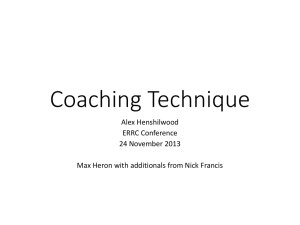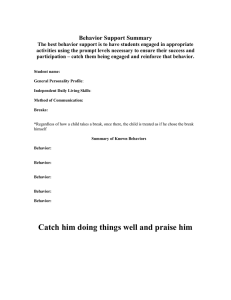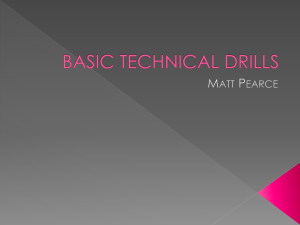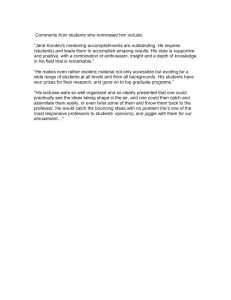Common Mistakes - Tempe Junior Crew
advertisement
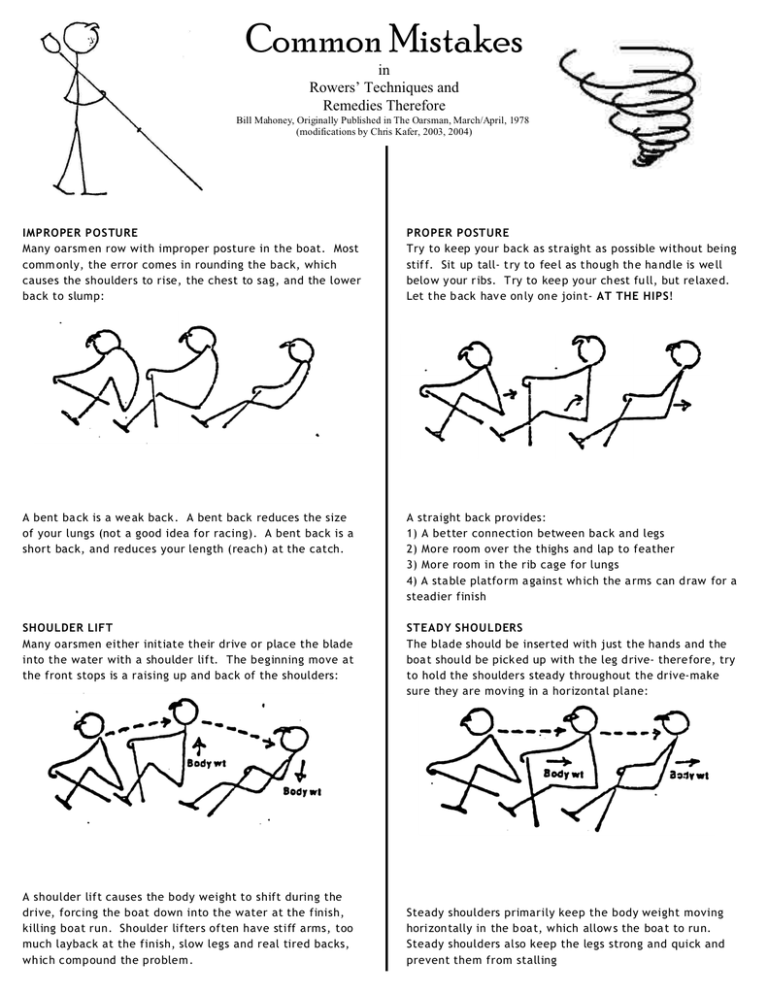
Common Mistakes in Rowers’ Techniques and Remedies Therefore Bill Mahoney, Originally Published in The Oarsman, March/April, 1978 (modifications by Chris Kafer, 2003, 2004) IMPROPER POSTURE Many oarsm en row with improper posture in the boat. Most comm only, the error comes in rounding the back, which causes the shoulders to rise, the chest to sag, and the lower back to slump: PROPER POSTURE Try to keep your back as straight as possible without being stiff. Sit up tall- try to feel as though the ha ndle is we ll below y our ribs. Try to keep yo ur chest fu ll, but relaxe d. Let the back hav e on ly one join t- AT THE HIPS! A bent ba ck is a we ak back . A bent back reduces the size of your lungs (not a good idea for racing). A bent back is a short back, and reduces your length (reach) at the catch. A straight back provides: 1) A better connection between back and legs 2) More room over the thighs and lap to feather 3) More room in the rib cage for lungs 4) A sta ble platfo rm a gainst which the a rms can d raw for a steadier finish SHOULDER LIFT Many oarsmen either initiate their drive or place the blade into the water with a shoulder lift. The beginning move at the front stops is a raising up and back of the shoulders: STEADY SHOULDERS The blade should be inserted with just the hands and the boa t shou ld be pick ed up with the leg d rive- there fore, try to hold the shoulders steady throughout the drive-make sure they are moving in a horizontal plane: A shoulder lift causes the body weight to shift during the drive, forcing the boat down into the water at the finish, killing boat run. Shoulder lifters often have stiff arms, too much layback at the finish, slow legs and real tired backs, which compound the problem. Steady shoulders primarily keep the body weight moving horizontally in the b oat, which allow s the boa t to ru n. Steady shoulders also keep the legs strong and quick and prevent them from stalling SHOO TING T HE TA IL We stress leg drive, but leg drive is ineffective if the oarsman is weak in the lower back and kicks without holding against the legs in the lower back. The result of this is “shooting the tail”, driving the legs without moving the boat: Shooting the tail loses all the punch at the catch, since the oar handle does not move and you do, and the footboards (hence , the bo at) receives a big ba ckw ard pu sh. This backward push kills the run, causing the boat to “check”, or slow down or stop before each catch. PROPER CONNECTION Try to be “set” against the legs in the lower back at the catch. The “set” should feel roughly as you would if you were doing cleans or dead lifts. By bracing the back vs. the legs, you can use the legs as the prime movers through the drive. Try to feel the set in the lower back, beginning just above the hips. Make your back so strong and firm that you know that for every inch you drive on the slide, you move the oarhandle a corresponding inch, and you will always have a light, quick feel in your boat. FALLING INTO THE CATCH Oftentimes, crews tend to fall, or lunge, or drive into the catch. This means that just before the catch, the crew tries to get enough (or extra) reach by suddenly bending forward more and stretching the body and arms: PROPER BODY CONTROL AT THE CATCH This can be attained by: 1) recovering in proper sequence (hands away quickly, then lean forward from the hips getting body angle while legs are still down, then come easily up the slide); and 2) as you approa ch the ca tch, start to set in the lower back. This malady leads to shooting the tail, since your ove rextended b ack can’t hold effe ctive ly against the legs. The m om entum into the stern from the lunge is hard to break, so your catc h w ill be slow and your bo at w ill probably have a severe check By angling from the finish position, you m ake it easier to get your body angle. By anticipating your set in the lower back, you stop the forward momentum of your slide, and can reverse direction easily and quickly (efficient transfer from recovery to drive at the catch) FALLING INTO THE FINISH Some crews have a problem with too much layback. The crew can’t pick the boat up quickly at the catch, so they try to send the boat out with a hard finish. Hard finishes tend to cause loss of body control and falling, or slumping, into the finish PROP ER BODY CONT ROL A T THE F INISH 1) Open the back sharply and quickly just before the legs are used up (never more than 10-15o past perpendicular), and then catch the back when it is fully with the stomach musc les; a nd 2) draw with the arm s against the oarhandle to help stomach muscles stop the body momentum into the bow. excessive layback not only dumps your boat down into the water, and kills run, but it also makes it hard to row high cadence, makes your abdom inal sore, and gives you less room in your lap to feather It is most difficult, but most im portant to learn ho w to control your body at the finish. You will find that feathering the oar is far simpler when you are sitting perfectly still at the finish and you can do this only by catching yo ur body w ith the stom ach and saving the a rms to help control the finish SHRUGGED SHOULDERS Many oarsmen row with their shoulders practically stuffed in their ears. They do this usually for two reasons: 1) They need to push the shoulders up and forward to get enough reach at the catch; and 2) they lift their elbows high to get the oa r up w here they ca n feather. The se problem s are often related to slouching, also HOLDING YOURSELF UPRIGHT A stock phrase is “shoulders down, chest up.” This means that the shoulders should be completely relaxed around the neck and collarbone while rowing. Often sitting a shade taller and firmer from th e low er back will solve the pro blem. If yo u ca n’t feather you ha ve to read a little more and row a lot more. Shruggers are uptight oarsmen. Either they can’t feather and are afraid th ey’ll crab, or the y don’t recover correc tly and have to lift up over their knees, or they can’t follow the stroke and are afraid the co ach w ill see it. The more you can relax and turn o ff m uscle s which aren ’t required for rowing, the more efficient your rowing will be. BOBBING HEAD AND SIGHTSEEING Most people’s heads weigh 10-12 lbs. If you toss it up and down during the drive, again (like the shoulder lift) you hurt the run of the boat THE HEAD (NOGGIN) Try to keep the head moving in the same horizontal plane throughou t the stroke cycle (like the shoulders). Try to keep relaxed in the jaws and face. Sightseers are people wh ose attentio n sp an are comparab le to fou r-year-olds and mu st look out o f the bo at. The y are also people who are never on time at the catch, who always rush their slide, and who crab out in tight races. You must keep your eyes in your boat! The coxswain can tell you all you need to know. Preferably look at the back of the man in front of you, or stroke or seven’s oarlock (don’t watch their blade, you’ll always be late). But crew is a tactile sport, and you will never be successful if you cannot concentra te and feel out the boat’s motion and how your m ovem ent is relating to it. THE IDEAL STROKE Begins as you a pproach the front stops. The weight of the hands comes off the handle, the blade descends towards the water, the lower back sets, and the hands rise and proceed forward. Then the blade falls into the water and the legs stomp, driving against the set back. THE IDEAL RECOVERY This really begins w hen the arm s draw level to or slightly past the body. By this time, the body should be still and the ha nds feather a nd press aw ay qu ickly until the arm s are loosely extended. Then the shoulders and upper body, which were riding at the finish position, rock forward from the hips, getting full body a ngle for the next catch. This is a smooth and continuous motion. The oar never stops moving. Just before the legs finish, the back opens hard to 10 o -15o. Just before the back finishes the arm s start to draw , to finish out the stroke a nd to stop the body’s m om entum into the bow. The style is legs, back and arms, with heavy emphasis on the legs and back. It is a sequence of moves. “Lift and set, catch, LEGS , BACK, arm s.” The legs then release and the slide rolls easily forward as the knees co me up und er th e arm pits . The recovery should be as slow and gentle as possible to maximize run and should always take nearly twice as long as the drive at low cade nce. Th is ratio betw een quick driv e and long rec overy is called “swing”. Hands away quickly. Approximately the same speed as they come in. No pausing at the body! PART II. Hands and Bladework IMP RO PER G RIP Very few oarsmen hold their oars correctly. Some clamp on so tigh tly (death grip) that you c an see their kn uckles tu rn white. Others hold the oar so loosely, and actually take their fingers o ff the han dle at odd m om ents (pian o pla ying ). PR OP ER GR IP 1) The outside han d (left if you ’re port, righ t if you’re starboard) should be at the end of the handle, pinky finger parallel to or overlapping the butt end. 2) The inside hand should be two widths of your hand (thum bs include d) do wn the h and le. In other wo rds th ere’s two hand-widths between your hands on the handle. 3) The oar should be held between the joint of the thumb and the face of th e fing ers. At no time shou ld the palm fully contact the oar handle. If you have big palm blisters, you are holding the oar too tightly. If you have blisters on the span of your thumb, you are holding the oar too tightly. Other problems include: hands too close together, hands too far apart, hands too far down the handle, hands not responding to brain, etc. etc. 4) The oar is held in the crook of the four fingers at the top of th e pa lm. Do not squeeze the handle when you drive. Let the oar sit snugly up against the four fingers and keep the thumbs in loose contact with the handle. WRIST COCKING Incredibly, m any o arsm en ca nnot u ndersta nd w hy their forearms get tight, or why someone else’s do not. The problem is called wrist cocking an d it is simply driving with the back of the hand at an angle to the forearm. RELAXING THE WRISTS Both the fingers and wrists must relax before relaxation can be achieved totally. Therefore, it is important to make sure that the wrists are not cocked. Check to see that the backs of your hands are parallel with the plane of your forearms. This habit invariably creates problems like: Squ eezing the handle No room in lap to feather Feathering with both hands Tightness in arms and upper body This should be the po sition fo r both hands. If you hav e to do s om ethin g stra nge with yo ur feathering han d, yo u do n’t yet know how to feather correctly. In the draw ing, note that there is daylight showing between the palm and handle. That is how your hands shou ld look. FEATHERING This is the most difficult aspect of rowing to learn. Many oarsmen row for years without doing it properly, some never get it right. The improper techniques are too various and unbelievable to portray here, but in general, problems stem from either: 1) Quick jamming the wrist down at the finish and trying to press away with the wrist tucked under the handle. FEATHERING PROPERLY 1) You must attain body control at the finish first. You must stop the mom entum into the bow w ith the stomach and the draw of the handle, and give yo ur hands a still platform to work o ff. 2) Press down first to get the blade out of the water. If you have stopped your momentum and the handle, all you need is a slight downward pressure and the handle will go straight down. Wrist jams as handle comes toward the body, thumb squeezes handle. Results: no body control or relaxation at the finish, no room to press down to get the blade off the water, scraped thighs, tight forearms. Also impossible to reach for the catch carrying the wrist under the handle. 2) Feathering the blade while still pulling Any form of feathering while still pulling makes it difficult, if not impossible, to be doing any of the following: 1) balance the boat; 2) get the b lade off the w ater; 3) get your bo dy off the back stops and row at high cadence. Notice in the diagram how the handle level remains the same, only the wris t goes dow n. You cant get the blade off the water that way. Similarly, you can’t get the handle away and your body back up the slide if yo u don’t stop the handle and your body momentum 3) Press away as th e lip of the blade clea rs the wa ter. If you have drawn properly, there will be a slight bend in the wrist o f your fe atherin g han d. All you n eed to do is straighten out that bend and let the thumb relax and rest loose ly on th e ha ndle. If the thumb is loose the straightening of the wrist will make the oar fall flat in the lock. BAD CATCH ES Bad ca tche s are usua lly wh y a crew is unsucc essful. The catch is the most important part of the stroke! Here a re ways in which oarsm en butcher their catches: 1) Missing water (rowing it in) TH E CAT CH AN D H OW TO DO IT 1) It begins by squaring the blade properly. When the handle is over the shins, the blade should be squaring (not before, not after). Getting the timing right requires anticipation. Blade should be fully squared by 3/4 slide. 2) Chopping 2) As you approa ch the front stops a nd full reach, begin to tak e the w eight o ff your hands and allow the blade to fall into the wa ter as you reach out. Your hands should follow a small semi-circle around the catch turn, and should make the turn in a split second. The catch is part of the recovery NOT part of the drive! 3) Knifing(digging deep) 3) If you begin th e ha nd movem ent of the catch pro perly (before full reach), the blade will catch the water properly. Rem em ber, gravity will put the blade into the water faster than you will. Don’t try to be quick and force the blade, just anticipate each move before it happens, be relaxed and the m ove w ill come along prop erly The catch is most difficult to learn, but it is the key to boat speed. A quick, hard catching crew will beat a mushy, slow crew anytim e. As a stro ng, hard-chargin g line in foo tba ll can dom inate a game, hard catches can dom inate a race When you feel th e blade splash into the w ater, imm ediate ly explode with the legs and the set back. This will give you the qu ickness required for real speed. Part III: The Slide ABUSING THE SLIDE Many young oarsmen abuse the slide by hitting either the front or re ar stops wh ile row ing o r by ru shing the slide. These problems are simply remedied. 1) Hitting the rear stops means you need to move the foots tretchers tow ards th e stern 2) Hitting the front stops means you may need to move your footstretcheers toward the bow. It may also mean that yo u are w ithout b ody c ontro l at the ca tch, or a re row ing witho ut body angle 3) Rushing the slide: MOR E SLIDE ABUSE Just as a lot of oarsmen allow their hands to stop at the catch and get slow and in trouble, so do oarsmen allow their slides to stop a t the catc h (front sto ps). The diagram above shows how the slide can stop at the front stops. The time in seconds represents elapsed time of the stroke. He re the seat stays at the catc h for 0.5 seconds. Fo r that leng th of tim e you r weig ht is in the stern slowing the b oat. Rushin g is the e asiest w ay to kill the spee d of yo ur boa t; it me ans th at yo u com e bac k up th e slide in less time than it took you to drive through the water. At low cadence (22-28 spm) the recovery should take 1.5-2.0 times the amount of time it took to drive. Make the recovery slide long, slow, relaxed and feel the wheels turn. THE QUICK, LIGHT SLIDE Just a s the ha nds sh ould sw ing aro und th e catc h turn without stopping, so should the seat roll into and out of the catch w ithout stopping. He re is a different diagram to show how the slide a nd ha nds sh ould co ordina te for a lightning catch. If both the hands and the seat reverse direction simultaneously, and the blade is solidly buried, you will be mo ving the boa t. PART IV: RACING AND OARSMANSHIP TACTICAL ERRORS IN RACING Racing is a simple matter, really. You get ahead and stay ahead until the race is over. But some crews make classical errors which are explained here: 1) Fly and Die- You blast out to a big lead in the first 500M row ing 40 spm , never settle, never realize how high yo u’re rowing, and then break by 1000M as your opponent steams by rowing 33½. 2) Tortoise- Basically, you become afraid to hurt early, take the boat off the line too tentatively, and your opponent has an insurmountable lead by 500M. 3) Scrambling- You’re in the race OK, but you’re 1 to 3 stro kes higher th an your opponent, and the boat isn’t rea lly together and swinging. You will probably lose in the last minute of the race. 4) Sitting on a small lead- You get out by 6 seats or so on your o pponent a nd just sit th ere, hoping to hang on un til the finish. Meanwhile, your opponent sees you going now here , and gain s confide nce the lo nge r you sit the re. This is similar to: 5) Opening the door- Allowing an inferior opponentt to get a lead and keep it long enough to believe they can beat you. Then they get tough as you go down the course. 6) Breaking- Allowing a crew to beat you at once with a single decisive move. You race even for 1000M, then your opponent takes a 20 and moves four seats before you respond, and then your response is scrambled and not together because you got rattled. RA CING T O W IN Here are some general principles which will, if you can put them into practice, win you some races: 1) Execute your race plan. Particularly at the start, d on’t worry about your opponent; pay attention to executing your plan pe rfectly (right c aden ce, right m oves , etc.) Get it going w ell, the n bust it! 2) Be aggressive but under control. We call it violence in a bottle; yo u should be really keye d up a nd rea lly bustin’ it in a race, but not unconscious of what you are doing, not losing thought or concentration. Don’t let the race happen to you, make it happen. This will take care of fly and die, tortoise and scrambling. 3) Move on your opponent. Once you start moving, keep moving. Don’t sit on any lead – kill your opponent. If you are b ehind, do something–brin g th e slide und er control, take 20, stop them, stop them cold and come right back at them! Never stop moving, ahead or behind. A big move from behind can break a crew who is ahead of you, but scrambling. You never know how fragile their lead may be. 4) If an infe rior o ppo nent is leading you , make sure he is paying a te rrible price. Make him hurt fo r every se at, every inch. If you lose ma ke sure th ey bea t your be st. 5) Winnin g is a habit. Make it yours. It is a rea sonable goal to not lose a piece, even a single 20, all year long. Do you have that kind of pride? Do you care enough? All real champions do. It doesn’t take that much more to win, but it does take those corny virtues – Courage, perserverance, pride, strength and heart. Are y ou that kind of perso n? Find out!!
